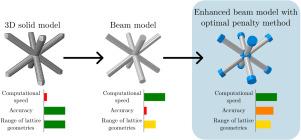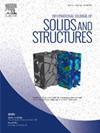An optimal penalty method for the joint stiffening in beam models of additively manufactured lattice structures
IF 3.4
3区 工程技术
Q1 MECHANICS
International Journal of Solids and Structures
Pub Date : 2024-10-16
DOI:10.1016/j.ijsolstr.2024.113107
引用次数: 0
Abstract
Additive manufacturing is revolutionizing structural design, with lattice structures becoming increasingly prominent due to their superior mechanical properties. However, simulating these structures quickly and accurately using the finite element method (FEM) remains challenging. Recent research has highlighted beam element simulation within FEM as a more efficient alternative to traditional solid FE simulations, achieving similar accuracy with reduced computational resources. However, a significant challenge is managing the lack of rigidity at nodes and the prevalence of low aspect ratio beams. While various methodologies have been proposed to address these issues, there is still a gap in the comprehensive evaluation of their limitations. An optimal node penalization methodology is required to expand the limited range of accurately represented lattice behavior. A preliminary study investigates lattice geometries through comparative analysis of solid and beam FE simulations. Built on this, we developed a methodology suitable to linear, dynamics and nonlinear beam FE simulations, contributing to enhanced computational speed and accuracy. Several lattice structures were printed using material jetting and quasi-static compressive tests were conducted to validate the methodology’s accuracy. The numerical results reveal a good accuracy between the proposed beam FE methodology and the experimental data, offering a better alternative to conventional FEM for energy absorption in terms of computing time.

用于叠加制造晶格结构梁模型连接刚度的优化惩罚方法
增材制造正在彻底改变结构设计,晶格结构因其卓越的机械性能而日益突出。然而,使用有限元法(FEM)快速、准确地模拟这些结构仍然具有挑战性。最近的研究表明,有限元法中的梁元素模拟是传统实体有限元模拟的一种更有效的替代方法,它能以更少的计算资源实现类似的精度。然而,一个重大的挑战是如何处理节点刚性不足和低纵横比梁的普遍存在。虽然已经提出了各种方法来解决这些问题,但在全面评估这些方法的局限性方面仍存在差距。需要一种最佳节点惩罚方法来扩大精确表示晶格行为的有限范围。一项初步研究通过对实体和梁的 FE 仿真进行比较分析,对晶格几何进行了研究。在此基础上,我们开发了一种适用于线性、动力学和非线性梁 FE 仿真的方法,有助于提高计算速度和精度。我们使用材料喷射打印了几种晶格结构,并进行了准静态压缩试验,以验证该方法的准确性。数值结果表明,所提出的梁有限元方法与实验数据之间具有良好的准确性,在计算时间方面,可以更好地替代传统的能量吸收有限元方法。
本文章由计算机程序翻译,如有差异,请以英文原文为准。
求助全文
约1分钟内获得全文
求助全文
来源期刊
CiteScore
6.70
自引率
8.30%
发文量
405
审稿时长
70 days
期刊介绍:
The International Journal of Solids and Structures has as its objective the publication and dissemination of original research in Mechanics of Solids and Structures as a field of Applied Science and Engineering. It fosters thus the exchange of ideas among workers in different parts of the world and also among workers who emphasize different aspects of the foundations and applications of the field.
Standing as it does at the cross-roads of Materials Science, Life Sciences, Mathematics, Physics and Engineering Design, the Mechanics of Solids and Structures is experiencing considerable growth as a result of recent technological advances. The Journal, by providing an international medium of communication, is encouraging this growth and is encompassing all aspects of the field from the more classical problems of structural analysis to mechanics of solids continually interacting with other media and including fracture, flow, wave propagation, heat transfer, thermal effects in solids, optimum design methods, model analysis, structural topology and numerical techniques. Interest extends to both inorganic and organic solids and structures.

 求助内容:
求助内容: 应助结果提醒方式:
应助结果提醒方式:


